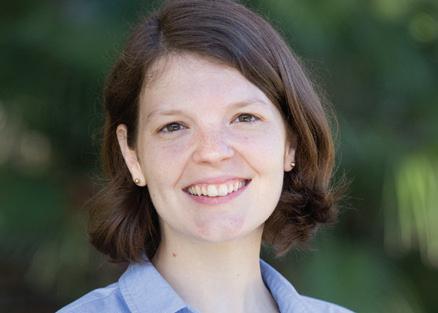MACH I N E LE ARN I NG
CAN AI CREATE BETTER CERAMIC COMPONENTS? Amanda Krause, Ph.D. ASSISTANT PROFESSOR
Ceramics have been used for everything from wall tiles and glassware to artificial hip joints, cruise missiles and the thermal tiles for NASA’s space shuttle. It should come as no surprise, as a long list of benefits including low electrical conductivity, high melting points and exceptional resistance to chemicals make ceramic materials ideally suited for all of these applications.
4
aircraft turbines regularly operate. Preventing that failure is at the heart of the latest research for Department of Materials Science & Engineering (MSE) Assistant Professor Amanda Krause, Ph.D., and her team consisting of UF MSE colleague Michael Tonks, Ph.D., Joel Harley, Ph.D., from UF’s Department
hold the key to predicting why one particular grain expands abnormally while the ones next to it quickly succumb. “The DOE was interested in looking at the behavior of materials in extreme environments like temperature or magnetic and electrical fields. Our project deals
“WE CAN ENGINEER NEWER, EVEN BETTER COMPONENTS WITH FAR SU PE R IOR STR E NGTH AN D FR AC TU R E T O U G H N E S S P R O P E R T I E S T H A N W H AT W E ’ R E S E E I N G F R O M T O D AY ’ S M O S T A D VA N C E D C E R A M I C M AT E R I A L S .”
While innovations in advanced ceramics have progressed over the past several decades, many of its traditional downsides still remain. For instance, the lighter weight and high temperature resistance that make today’s hi-tech ceramics ideal for aircraft turbines still comes at the price of an arduous and costly manufacturing process.
of Electrical and Computer Engineering and Michael Kesler, Ph.D., from Oak Ridge National Laboratory.
Additionally, along with ceramic’s inherent strength and hardness comes a susceptibility to total failure under the extreme load conditions of heat, steam and forces under which those same
Backed by a $1.26 million award from the U.S. Department of Energy’s (DOE) Basic Energy Sciences (BES) program, Dr. Krause feels that artificial intelligence (AI), specifically machine learning, may
Dr. Amanda Krause
with both high temperatures and magnetic fields,” said Dr. Krause. Ideally, the microscopic grains that make up any material’s structure are relatively uniform in size throughout a given sample — which is usually the case at normal temperatures. The problem comes when a material, such as Alumina, is heated to extreme temperatures


